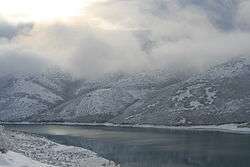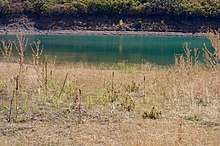Little Dell Reservoir
Little Dell Reservoir is a reservoir in eastern Salt Lake County, Utah, United States, about 13 miles (21 km) east of Salt Lake City in the western Wasatch Mountains.
| Little Dell Reservoir | |
|---|---|
 Little Dell Reservoir in early Spring, April 2009 | |
| Location | Salt Lake County, Utah, United States |
| Coordinates | 40.7730°N 111.6935°W |
| Type | Reservoir |
| Primary inflows | Dell Creek |
| Primary outflows | Dell Creek |
| Basin countries | United States |
| Surface area | 249 acres (101 ha) |
| Average depth | 82.4 ft (25.1 m) |
| Max. depth | 200.1 ft (61.0 m) |
| Water volume | 20,500 acre⋅ft (25,300,000 m3) |
| Surface elevation | 5,798 ft (1,767 m) |
Description
Little Dell is located alongside Utah State Route 65, about 1 mile (1.6 km) northeast of Interstate 80.[1] It is an impoundment on Dell Creek, but it also stores water diverted from Parleys Creek located immediately downstream. The reservoir was constructed between 1987 and 1993 for drinking water supply and flood control as a joint venture between the United States Army Corps of Engineers, Metropolitan Water District of Salt Lake City and Salt Lake County. The total cost of the project was US$63,864,932.00.[2] The reservoir and recreation area is operated and maintained by the Salt Lake City Department of Public Utilities.[3]
Construction of a storage facility on Dell Creek in Parley's Canyon, Salt Lake County, Utah was first considered in the late 1940s when Dr. Ray E. Marsell, geologist consultant for the Utah Water and Power Board, recommended the project to the Salt Lake City Commission. Interest in the project was rekindled in 1983 when East 1300 South in Salt Lake City was flooded for the second time in 31 years.[2]
The Little Dell Reservoir dam is a rolled earthfill structure. It has a maximum height of 224 feet (68 m) above the streambed and is 1,700 feet (520 m) in length.[4]

The recreation area at Little Dell is located near the site of a historic Pony Express station run by Utah pioneer Ephraim Hanks in the mid-19th century. Known as Little Dell Station, it was situated about 1,000 feet (300 m) northeast of the northernmost tip of the reservoir. The site was listed on the National Register of Historic Places in 1971.[5] None of the original structure remains.
Unlike nearby Mountain Dell Reservoir, fishing is currently allowed in Little Dell Reservoir. Little Dell contains Brook trout, Brown trout, and native Bonneville cutthroat trout. Special fishing regulations exist to protect the latter species. Access to the reservoir is only allowed through the recreation area. Because Little Dell is a watershed, there is no swimming, bathing or washing allowed within the reservoir. Motorized boats are also not permitted. Non-motorized craft, including windsurfing, is only allowed. However, standup paddleboarding (SUP) is not allowed.
Little Dell Reservoir can be best viewed from Little Mountain Pass, located at the top of Emigration Canyon.
See also
References
- http://www.utahfishinginfo.com/utahlakes/littledell.php
- "Archived copy". Archived from the original on 2011-05-03. Retrieved 2009-07-04.CS1 maint: archived copy as title (link)
- "Archived copy". Archived from the original on 2010-07-26. Retrieved 2009-05-21.CS1 maint: archived copy as title (link)
- http://www.waterquality.utah.gov/watersheds/lakes/LITTLEDL.pdf
- Smith, Melvin T. (May 15, 1971). "National Register of Historic Places Nomination: Little Dell Station" (PDF). National Park Service. Cite journal requires
|journal=(help) "Accompanying photo, from 1971" (PDF). National Register of Historic Places Inventory.
External links
| Wikimedia Commons has media related to Little Dell Reservoir. |